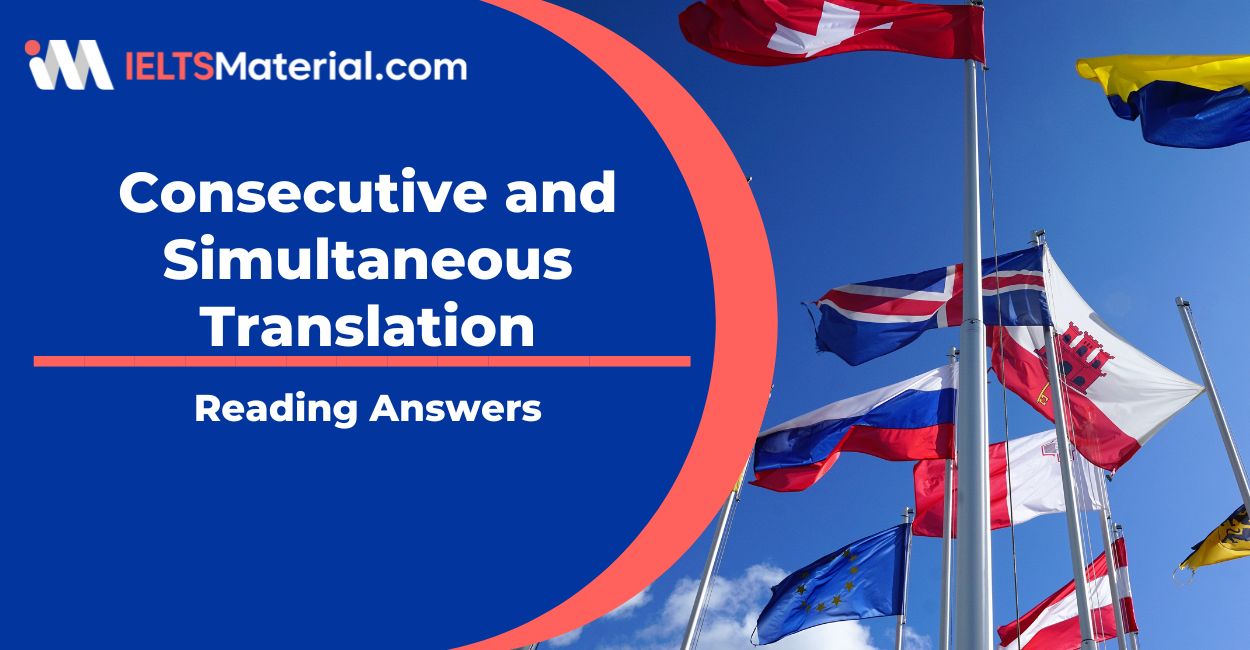Consecutive and Simultaneous Translation Reading Answers
2 min read
Updated On
-
Copy link
Table of Contents

Limited-Time Offer : Access a FREE 10-Day IELTS Study Plan!
Consecutive and Simultaneous Translation is a real IELTS Reading test passage from past papers.
Take the test now and check the Consecutive and Simultaneous Translation reading answers below.
With diligent practice, the Reading Module can be the top-scoring category for IELTS Aspirants. To score well, you must understand how to approach and answer the different question types in the Reading Module.
By solving and reviewing Sample Reading Questions from past IELTS papers, you can ensure that your Reading skills are up to the mark.
You can also try more IELTS reading practice tests.
Want to practice more Summary Completion questions? Start with IELTS Reading Summary Completion Topic 1.
Consecutive and Simultaneous Translation
You should spend about 20 minutes on Questions 1-13, which are based on the Reading Passage below.
Find the practice test with the Consecutive and Simultaneous Translation PDF here.
Answers
The answers to questions 1-13 are given below along with their explanations.
| Question Number | Answer | Keywords | Locations of Keywords |
|---|---|---|---|
| 1 | B | The term ‘translation’, is the neutral term used for all tasks where the meaning or expressions in one language (the source language) is turned into the meaning of another (the ‘target’ language), whether the medium is spoken, written, or signed. In specific professional contexts, however, a distinction is drawn between people who work with the spoken or signed language (interpreters), and those who work with the written language (translators). | Paragraph 1, Line 2 |
| 2 | D | Major linguistic exercise is taking place | Paragraph B, line 4 |
| 3 | C | One procedure, consecutive interpreting, is very old — and presumably dates from the Tower of Babel! | Paragraph D, line 2. |
| 4 | C | availability of modem audiological equipment and the advent of increased international interaction | Paragraph D, last two lines. |
| 5 | A | In this case he has to remember a great number of messages; and keep them in mind until he begins his translation. | Paragraph C, line 6. |
| 6 | 2-3 seconds | This ‘ear-voice span’ is usually about 2 or 3 seconds, | Paragraph E, line 7. |
| 7 | 10 seconds | but it may be as much as 10 seconds or so, if the text is complex. | Paragraph E, line 8. |
| 8 | 100-120 | input speed of between 100 and 120 words per minute | Paragraph G, line 3. |
| 9 | 200 | with an upper limit of around 200 w.p.m. | Paragraph G, line 5. |
| 10 | B | But even small increases in speed can dramatically affect the accuracy of output. | Paragraph G, line 4. |
| 11 | C | the presence of background noise, | Paragraph F, line 3. |
| 12 | E | cultural background also makes it aim to pay full attention to the backgrounds of the authors and the recipients, and to take into account differences between source and target language. | Paragraph F, line 4. |
| 13 | A | As you start a sentence you are taking a leap in the dark, you are mortgaging your grammatical future; the original sentence may suddenly be turned in such a way that your translation of its end cannot easily be reconciled with your translation of its start. | Paragraph E, line 10. |
Also check :
Practice IELTS Reading based on question types

Start Preparing for IELTS: Get Your 10-Day Study Plan Today!
Recent Articles

Nehasri Ravishenbagam

Haniya Yashfeen

Haniya Yashfeen

Haniya Yashfeen




Post your Comments